Cheramy
In 1921, Houbigant introduced a new perfume called Cappi into the American market. It was advertised as made by Cheramy, Inc., a new subsidiary that Houbigant had established at 102 West 72nd Street, New York with Robert Bienaimé [1876-1960] as its major shareholder.
See also: Houbigant
Cappi was designed to appeal to the women who had joined the workforce during and after the First World War. In American and Britain these young women were sometimes referred to as ‘flappers’ while in France they were known as ‘garconnes’. Employment gave these women a disposable income and, after paying for the basics – rent, food, utilities and clothing – many had a small surplus they could spend on other ‘necessities’ such as perfumes and cosmetics.
These women were still on a budget so Cappi retailed at a lower price than other Houbigant fragrances. This would explain the need to establish a new Cheramy subsidiary. Houbigant did not want to risk the cachet of the Houbigant brand by having it sell cheaper lines.
Naming the new company Cheramy, – which sounds like cher ami (dear friend) – created the impression that Cappi was French and this was reinforced in early advertisements.
Behind the new house of Cheramy is more than a century of perfume experience in France. Their rare flower essences will be distilled in the perfume gardens of Grasse, Cannes and Nice, and exquisite perfume bottles will come from Paris—even the tiny labels that seal them.
The essences imported from the oldest gardens of France will be blended here. In this way the house of Cheramy will give to America, at last, rare perfumes that are not extravagant. At last American women can have at little cost the same exquisite perfumes all French women use.(Cheramy advertisement, 1921)
However, rather than being formulated in France, it is generally believed that Cappi was developed by the American perfumer, Francis Miles, who was made a Cheramy vice-president and was also its resident chemist.
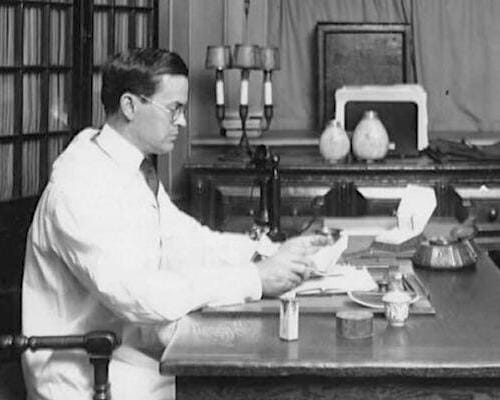
Above: This appears to be Francis Joseph Michael Miles [1882-1965], a.k.a. F. J. M. Miles, or Frank Miles. He joined Cheramy Inc. in 1921then becoming vice-president in charge of manufacturing for Houbigant, Inc. as well in 1926. He moved to Colgate & Company in 1927 and then on to Allen B. Wrisley Company in 1929. By 1932 he had relocated to California where he started his own perfume development business.
Miles had previously worked for Marshal Field and the Melba Manufacturing Company and was said to have created perfumes for both of them. If he did create Cappi, that might help explain why Houbigant debuted Cheramy in the United States rather than France. However, it might also be an indication of the strength of the American market which had come out of the First World War in better economic shape than its European contemporaries.
Following its success in America, Houbigant introduced Cappi into France. It founded the Société Anonyme des Parfums Cheramy (capital ₣500,000) at 19 Rue Cambon, Paris and began selling Cappi there in 1922. By the end of 1923, it was also distributed around the world to places where Houbigant was already established.

Above: 1927 Cheramy factory at 145 Avenue du Roule, Neuilly-sur-Seine.
A Parfums Cheramy store was also opened at 308 Rue Saint-Honoré, Paris in 1926.
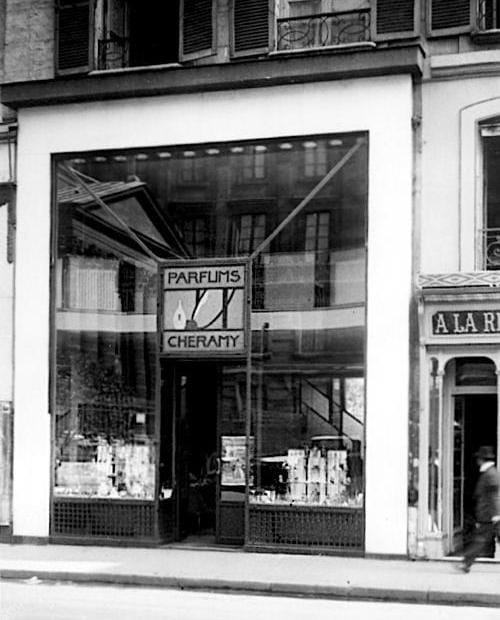
Above: Parfums Cheramy designed by the architects Gilbert Raguenet [1879-1978] and Camille Maillard [1885-1975]. It was constructed using stucco, glass and wrought iron in a style influenced by the Exposition Internationale des Arts Décoratifs et Industriels Modernes which took place in Paris in 1925.
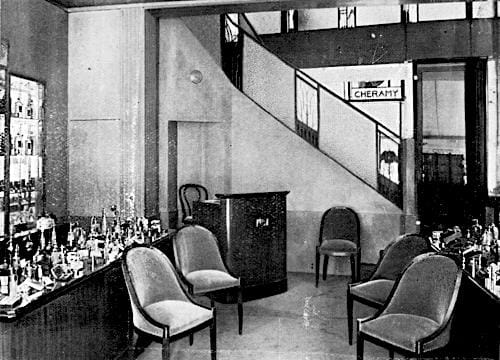
Above: 1927 Ground floor reception of Parfums Cheramy.
Products
A number of other Cheramy perfumes were introduced into the American market during the 1920s, the most important being April Showers (1924), Biarritz (1926), and Joli Soir (1929). This situation was not replicated elsewhere. April Showers and Biarritz did not appear in France or Britain in the 1920s and fragrances like Offrande and Fausta which were available in France and Britain were not sold in the United States. The reason for this is unknown to me.
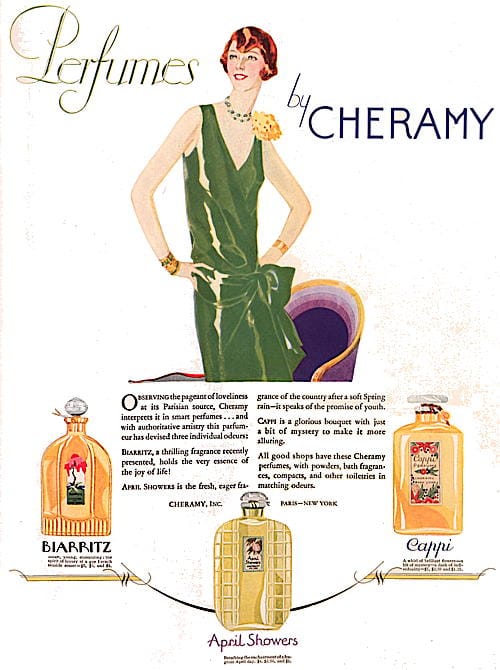
Above: 1927 Cheramy Biarritz, April Showers, and Cappi perfumes.
Make-up
The early Cappi range included a Face Powder, Compact Powder, and Compact Rouge.
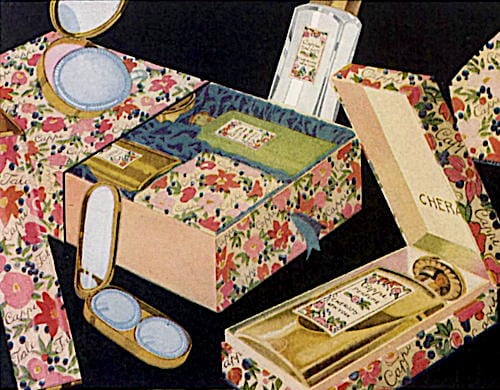
Above: 1922 Assorted Cappi products (USA)
The Chappi Face Powder shades in the United States were White, Light Flesh, Dark Flesh, Light Brunette, and Dark Brunette but the Compact Powder only came in White, Flesh, and Brunette. Both shade ranges were expressed in English rather than French. Later face powders fragranced with April Showers or Biarritz also came in the same shade range while in France and Britain they were the same as those for Houbigant – Blanche, Rosée, Rachel, Naturelle, Ocre, Ocre Rosée, and Rachel Soleil with Ocre Bistre added by the end of the deacde.
The early American Cheramy range also included Cheramy Lov-Lor, and Cheramy Theatrical Powder.
Cheramy Lov-Lor was a cold cream face powder released soon after Cheramy, Inc. was established. It was probably made along the lines of Leichner’s Fettpuder or Armand’s Cold Cream Powder. Unlike other Cheramy face powders it came in a square aluminium box, presumed to have been designed by Lalique, rather than the usual round cardboard box, perhaps because of worries that the oils in the powder would stain the cardboard. The aluminium boxes were stamped with made in France but Lov-Lor does not appear to have been available there. All the boxes I have seen are marked Cheramy, New York and the powder appeared there before Parfums Cheramy was founded in Paris.
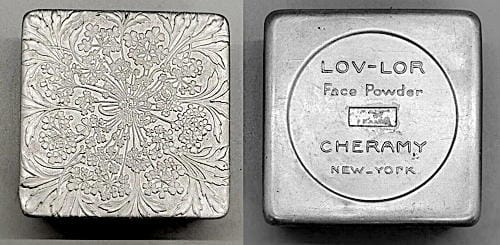
Above: Cheramy Lov-Lor powder box stamped ‘Made in France’.
Cheramy Theatrical Powder (1924) is a bit of a mystery. It was supposedly developed for use on the stage but it is hard to see who would have preferred it to regular stage make-up. Like Lov-Lor, I have not been able to find any trace of it in Europe or Britain.
Cheramy Lov-Lor Powder: “[P]roduced from the finest essential oils and blended with a finely texture powder into a face powder that has no equal in price.” Shades: As for other face powders.
Cheramy Theatrical Powder: “[R]emains true to shade under the glare of stage lights—adheres unusually long and is compounded of ingredients that are beneficial to the skin.” Shades: As for other face powders.
The Cappi range came with a compressed rouge but did not include a cream rouge with Cheramy adding one with the April Showers range. This Permanent Rouge came in Cherry Red, Carnation, and Orange shades and could be used on the lips or cheeks. By 1926, Cheramy had added simple push-ups lipsticks in the same three shades – Cherry Red, Carnation, and Orange. The Permanent Rouge and lipsticks were also sold in France in Carmin, Grenat and Orange shades.

Above: Cheramy Lipstick.
Skin-care
By 1924, Cheramy had added a Cold Cream, Cleansing Cream, and Greaseless Cream to the Cappi range along with Bath Salts, a Brilliantine and a Bandoline. The skin creams were packaged in distinctive jars but I have only seen drawings of these rather than actual examples.
In 1926, Cheramy replaced the three Cappi creams with three Youth Creams in new more modern-looking jars. This was presumable done so that they could be matched with April Showers as well as Cappi, the two fragrances often advertised together as ‘Perfumes of Youth’.
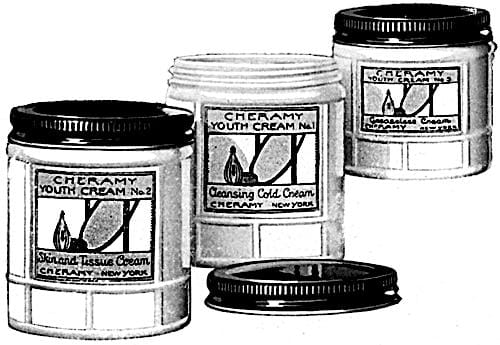
Above: Cheramy Youth Creams.
Youth Cream No. 1 (Cleansing Cold Cream): “[I]s for thorough cleansing, the very foundation of skin beauty. It goes to the base of the pores and brings to the surface all hidden impurities and the imbedded grime that clogs the pores and spoils natural beauty. This cream prevents coarse pores, blemishes and rough texture and makes the skin glow with healthful cleanliness.“
Youth Cream No. 2 (Skin and Tissue Cream): “[N]ourishes the skin. It restores worn tissue and erases the fine network of lines around the eyes. It enables the skin to relax—so that faint creases around the nose and mouth gradually fade away, leaving a smooth, firm contour that seems to take years from one’s whole appearance.“
Youth Cream No. 3 (Greaseless Cream): “[P]rotects the sensitive skin, resisting sun, dust, and wind. It gives the skin a soft, fine texture, and supplies an ideal base for rouge and powder.“
The only additional skin-care cosmetic introduced by Cheramy in the 1920s, that I know of, was Cheramy Lotion, an almond lotion, perhaps similar to the very popular Hinds Honey and Almond Cream.
Cheramy Lotion: “[A] soothing almond lotion for irritated skins, and to prevent sunburn, windburn and chapping.”
See also: A. S. Hinds
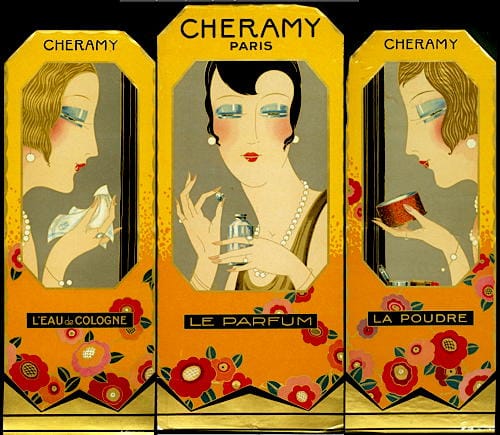
Above: c.1929 Panels from a three-fold screen for Cheramy Eau de Cologne, Parfum, and Poudre (UK).
1930s
By the late 1920s, the Cheramy range appeared to be doing well leading the French company, Parfums Cheramy, to increased its capital stock from 5,000,000 to 15,000,000 franks in 1928. Unfortunately, the hopes for the range largely evaporated during the depression years of the 1930s. During this time Cheramy’s promotional efforts increasingly centered on the few lines that had reasonable sales – its eau de Colognes, dusting and talcum powders either scented with Cheramy perfumes or the more generic floral fragrances added in 1927.
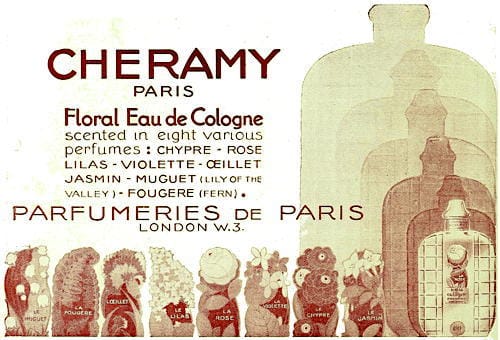
Above: 1927 Cheramy Floral Eau de Cologne (UK).
Cheramy did introduce a number of new perfumes during the 1930s but I have been unable to find any new skin-care cosmetics and only a few new forms of make-up. Like Houbigant, it introduced additional shades to its face powders and rouges during the 1930s and also added eye make-up including a cake mascara and an eyeliner.

Above: Cheramy Crayon Pastel. Shades included Noir and Brun.
In 1932, Cheramy also introduced a nail polish – Émail Permanent pour les ongles in Rouge, Rouge Foncé, Rouge Clair, and Incolore shades along with a polish remover. It was available in France and Britain but I have no evidence for it in the United States.
War
Cut off from France, Cheramy, Inc. did manage to introduce a few new items in the United States, most notably Cheramy Skin Balm in 1942 and Frolic perfume in 1943. The Frolic series only extended to Perfume, Dusting Powder, Eau de Cologne and Talcum Powder. There were no Frolic skin-care lines or make-up.
Cheramy Skin Balm was promoted as a general body lotion and skin protector and also became available in France after the war. After 1945, it was advertised in the United States as containing lanolin and then later said to contain Emolline No. 7, a reflection of the post-war fad for scientific-sounding wonder ingredients.
Cheramy Skin Balm: “[C]ontains quick-smoothing emollient oils that soften and soothe dry, sensitive, roughened skin. Use on hands, elbows, knees and legs before and after exposure to weather. Refreshing as an after-bath lotion. Flattering as a powder base.”
Post war
Like others of their type, demand for Cheramy Dusting Powders and Talcum Powders began to fall after the Second World War as sales of deodorants and antiperspirants rose. Cheramy, Inc. responded to this trend by adding April Showers Deodorant Talc and April Showers Stick Deodorant in 1951, and April Showers Liquid Cream Deodorant in 1954. Hexachlorophene was added to the Deodorant Talc in 1957 and an aluminium salt to the Stick Deodorant in 1959 which turned it into an antiperspirant.
April Showers Deodorant Talc: “[G]ives all-over body protection, absorbs moisture. Lightly scented.”
April Showers Stick Deodorant: “[A]ways safe . . . always sure . . .and is so easy to apply. Just glide it on—it works like a charm without dripping, smearing or staining. Delightfully scented with lovely April Showers perfume.”
See also: Hexachlorophene and Deodorants and Antiperspirants
End of the line
The Cheramy line limped on for decades after the war. I do not know exactly when it was discontinued but its products disappeared sometime in the 1980s.
Timeline
| 1921 | Cheramy, Inc. established in New York. New Products: Cappi range (USA). |
| 1922 | Parfums Cheramy S.A. founded at 19 Rue Cambon, Paris. |
| 1924 | Cheramy Limitée founded in Montreal. New Products: April Showers range; and Cheramy Theatrical Powder (USA). |
| 1926 | Paris shop opened at 308 Rue Saint-Honoré. New Products: Cheramy Youth Creams (USA). |
| 1942 | New Products: Cheramy Skin Balm (USA). |
| 1951 | New Products: April Showers Deodorant Talc; and April Showers Stick Deodorant (USA). |
| 1954 | New Products: April Showers Liquid Cream Deodorant (USA). |
First Posted: 15th July 2024
Sources
The American Perfumer & Essential Oil Review. (1906-1955). New York: Robbins Perfumer Co. [etc.].
The Drug and Cosmetic Industry. (1932-1997). New York: Harcourt Brace Jovanovich [etc.].
La parfumerie française et l’art dans la présentation. (1925). Paris: La Revue des Marques de la Parfumerie et de la Savonnerie.
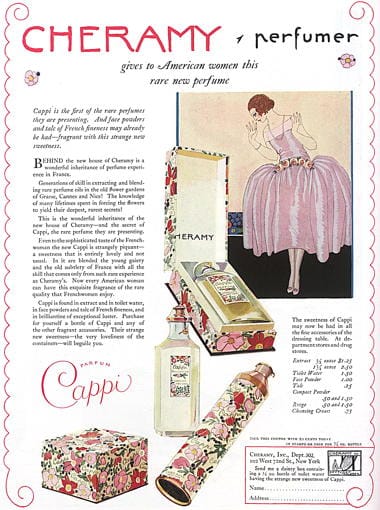
1922 Cheramy Cappi (USA).
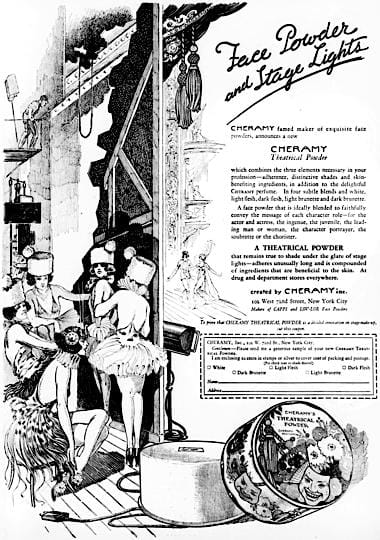
1924 Cheramy Theatrical Powder (USA).
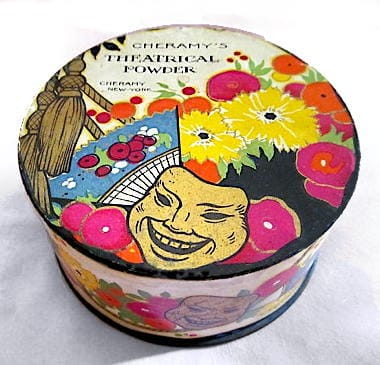
Cheramy Theatrical Powder (USA).
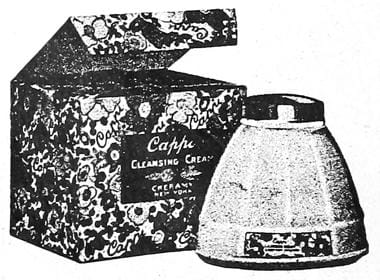
1925 Cheramy Cappi Cleansing Cream (USA).
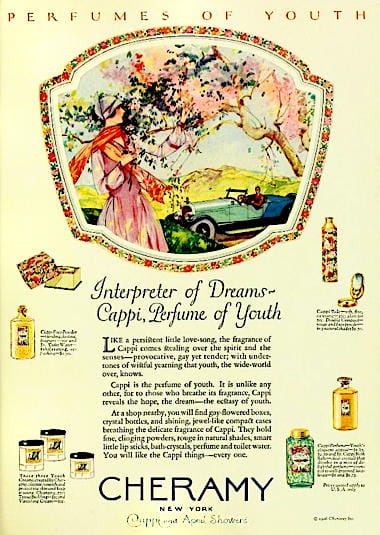
1926 Cheramy Cappi and April Showers, Perfumes of Youth (USA).

1926 Cheramy Youth Creams (USA).
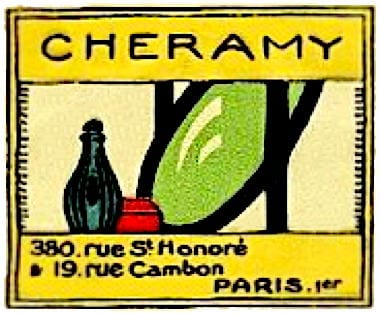
Parfums Cheramy (France).
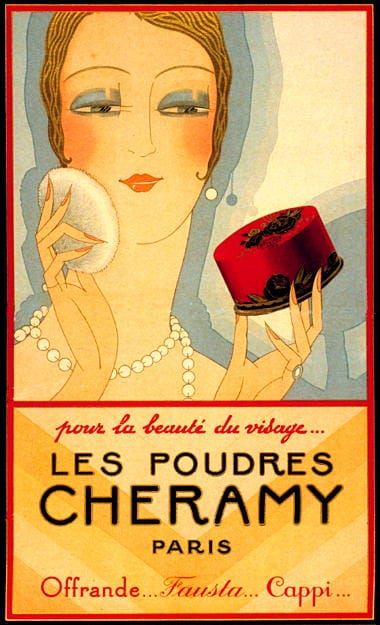
Poudres Cheramy – Offrande, Fausta, and Cappi.
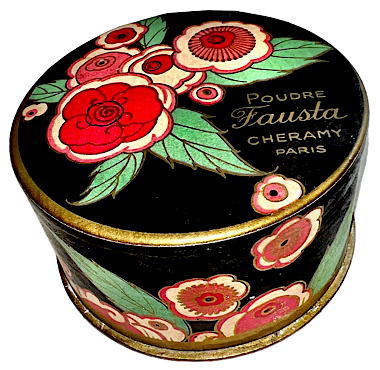
Cheramy Poudre Fausta in Blanche, Rosée, Rachel, Naturelle, Ocre, and Ocre Rosée shades.
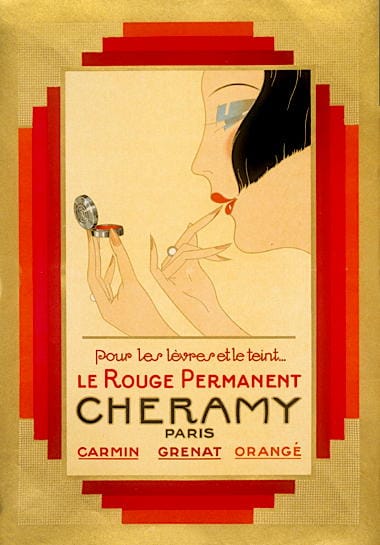
1927 Cheramy Rouge Permanent. In America it was sold in Cherry Red, Carnation, and Orange shades.
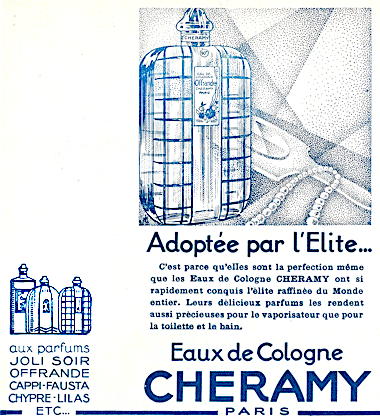
1928 Cheramy Eaux de Cologne.

Cheramy Eau de Cologne.
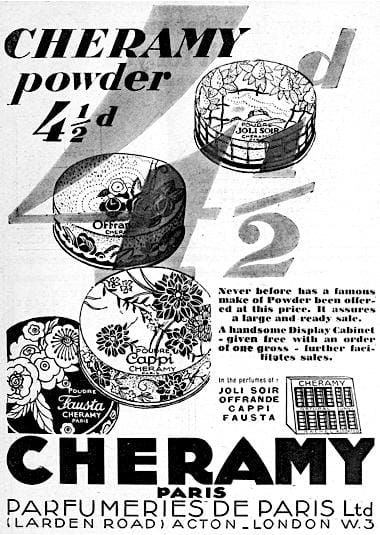
1929 Trade advertisment for Cheramy Fausta, Cappi, Offrande, and Joli Soir Face Powders (UK).
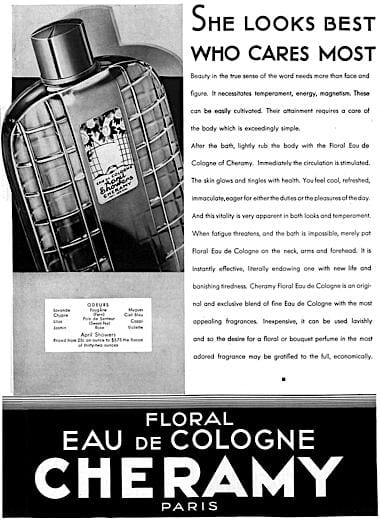
1931 Cheramy Floral Eau de Cologne (USA).
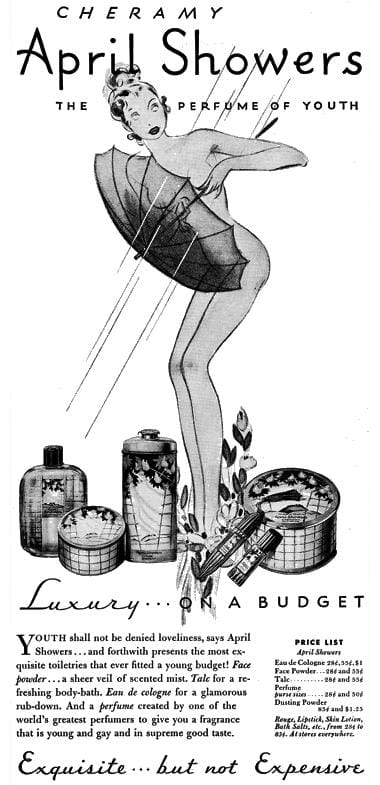
1935 Cheramy April Showers (USA).
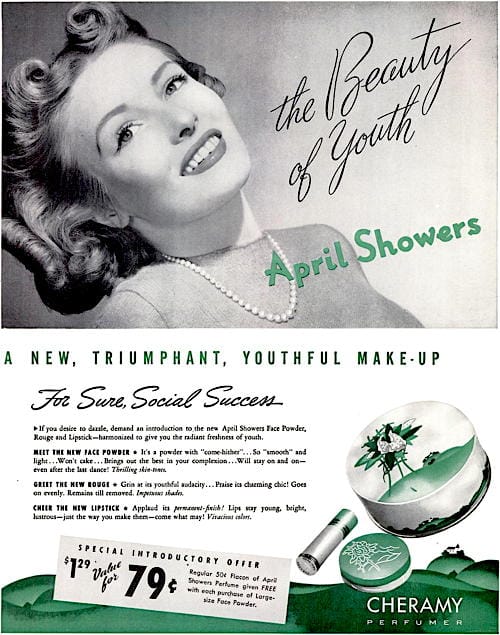
1940 Cheramy April Showers (USA).

1945 April Showers Talc and Deodorant Talc (USA).
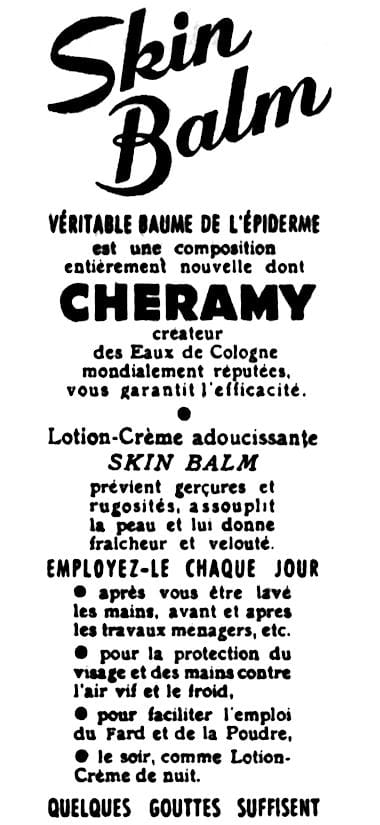
1948 Cheramy Skin Balm.
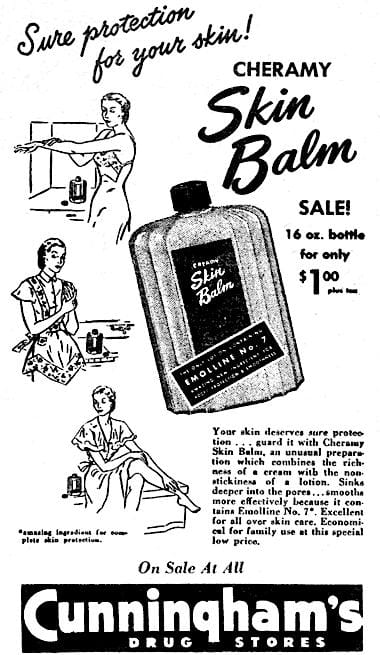
1953 Cheramy Skin Balm (USA).
